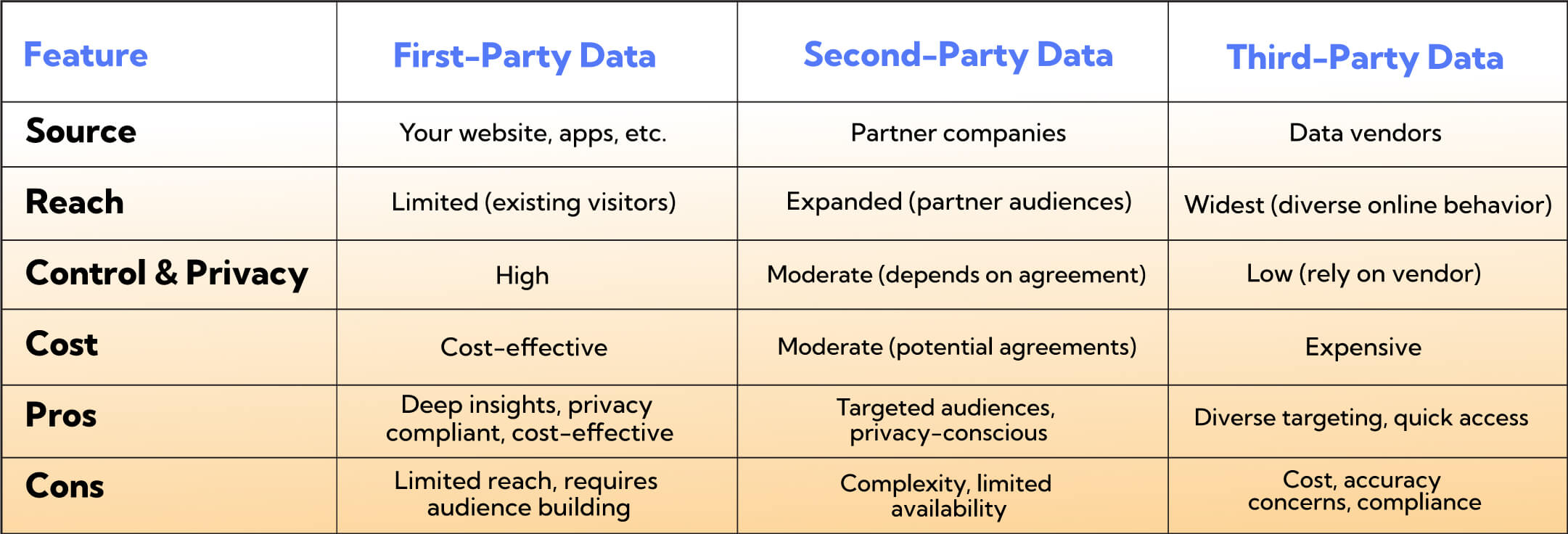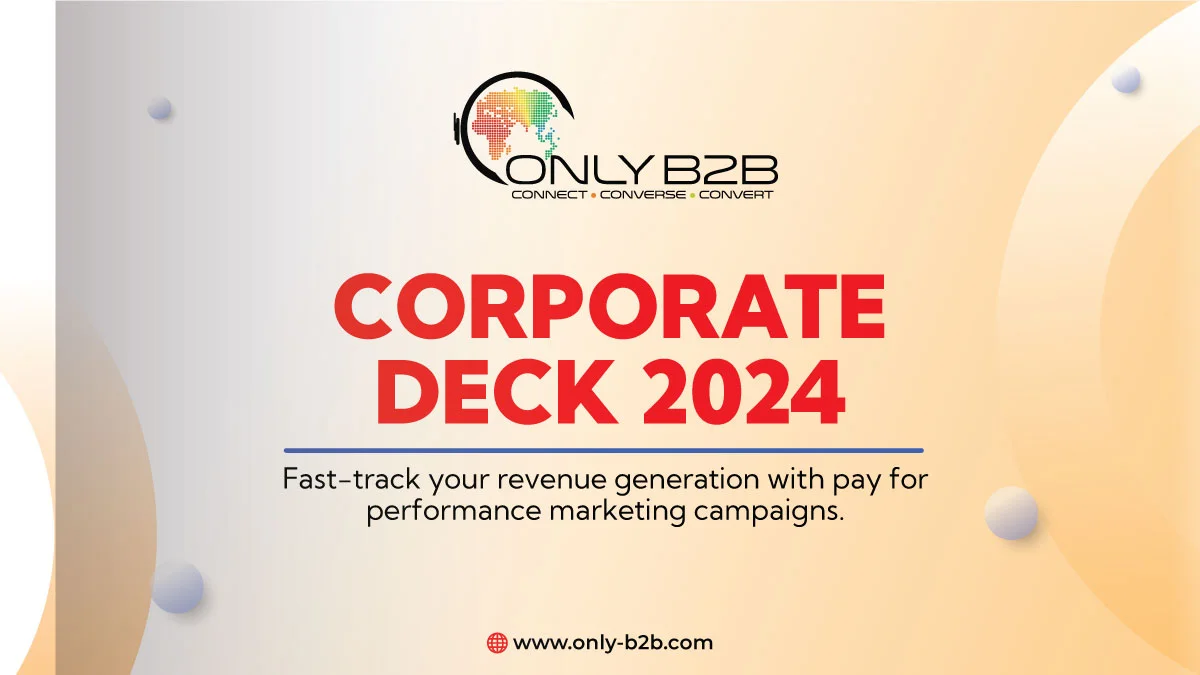
With the market becoming saturated with businesses, attracting the right buyers requires precise targeting. That’s where intent data comes in as your compass, helping you identify potential customers actively searching for solutions like yours.
But with different types of intent data available – first-party, second-party, and third-party – choosing the right one can feel like a complex puzzle.
This begs the question: what type of intent data works best for growing your business?
We’ll break down types of intent data that tackle your business goals:
Must Read: 10 Key Game-Changing Benefits of Intent Data
First-Party, Second-Party, Third-Party Intent Data: Diving into Notable Differences
Table of Contents
But first, let’s understand what we mean by intent data.
Understanding the Buyer Journey: It’s All About “Intent”
Imagine a customer embarking on a buying journey like a treasure hunt. First, they realize they need something (the map). Then, they research solutions (following clues).
Finally, they choose the best option (claiming the treasure!). Intent data helps you identify prospects at each stage, allowing you to:
- Know what they’re interested in and personalize your communication.
- Provide valuable content and resources at each stage of their journey.
- Focus your efforts on prospects most likely to buy, maximizing your results.
Must Read: What is Intent Data and How it Can Help Your Company?
Let’s explore the three distinct types of intent data to drive you to sales:

1. First-Party Intent Data:
Did you know?
Companies that prioritize first-party intent data are 2.3 times more likely to outperform revenue goals than those that don’t.
[Forbes report]
This data comes directly from your digital properties – website visits, webinar registrations, form submissions, and social media interactions. It’s like the treasure mcap you’ve created, offering deep insights into your audience’s interests and behaviors.
For instance:
Your visitor is lingering on your pricing page, hinting at interest but not quite clicking “buy”. First-party data is the rescue!
So how can you use this information?
Analyze visitors’ dwell time, visited pages, specific feature interactions, and even if they started but abandoned the demo form. This paints a detailed picture of their intent and concerns.
Segment high-intent visitors, personalize emails with pricing breakdowns, offer live chat support, and even retarget them with ads addressing their specific hang-ups.
Voilà! You’ve turned a hesitant browser into a sales-ready lead.
Hold on! here’s the comprehensive picture:
Pros:
- Control and Privacy: You own and manage the data, ensuring compliance with regulations.
- Richer Insights: Provides a deeper understanding of your audience’s interests and behaviors.
- Cost-Effective: Usually requires minimal additional investment beyond existing tools.
Cons:
- Limited Reach: Relies on existing website traffic, potentially missing new prospects.
- Building an Audience: Requires ongoing effort to attract and engage visitors.
Must Read: How to Collect B2B Intent Data?
Second-Party Intent Data:
Imagine partnering with non-competitive companies to exchange relevant audience data. This expands your reach while maintaining control, like sharing clues with friendly explorers.
For instance:
You are selling marketing automation software but find it challenging to reach the right prospects. Solution- partner with a CRM provider. Leverage their anonymized data on prospects actively researching similar tools.
See which features they prioritize, even how they view competitors. Tailor your message, target with laser precision, and turn “prospecting” into “precise targeting.“
Remember, choose trusted partners and segment the data for the maximum impact.
Now, let’s shine a light on the pros and cons:
Pros:
- Expanded Reach: Access data from new audiences beyond your website.
- Targeted Audiences: Partner with companies whose audience aligns with your ideal customer profile.
- Privacy-Conscious: Often involves data clean rooms and encryption for secure exchange.
Cons:
- Complexity: Requires agreements and data quality checks with partners.
- Limited Availability: Finding suitable partners with compatible data might be challenging.
Must Read: Virtual Prospecting with Intent Data
Third-Party Intent Data:
This involves purchasing data from external vendors who gather intent signals from various sources. While offering the widest reach and diverse targeting options – it can be expensive and requires careful vendor selection regarding data accuracy and compliance.
Third-party data- a huge pool of potential leads, but fish responsibly!
(Source: Gartner CMO Spend Survey 2023-2024).
30% of B2B marketing leaders report experiencing data quality issues with third-party intent data providers
Here are pros and cons consider:
Pros:
- Widest Reach: Access vast datasets encompassing diverse online behaviors.
- Diverse Targeting Options: Target based on specific interests, purchase intent, and industry verticals.
- Quick Access: No need to build your own data infrastructure.
Cons:
- Cost: Can be expensive compared to other options.
- Accuracy Concerns: Data quality and freshness might vary depending on the vendor.
- Privacy Regulations: Navigating compliance issues requires careful vendor selection.
Must Read: Win B2B Event Marketing with Intent Data
Choosing Your Data Weapon: What Fits Your Quest?
As a B2B marketer, you are likely to wear multiple hats. Decide what it is, what you want, and what it is you don’t – to find the perfect intent data solution. Not one-size-fits-all, and so choosing the perfect type of intent data depends on the products or services you offer.
For ABM strategies, leveraging ABM intent data is crucial to identify high-value accounts exhibiting buying intent. This allows for targeted outreach and messaging tailored to their specific needs and challenges.
While choosing your intent data weapon, these are a few key considerations to keep in mind:
- Start with First Party: Leverage your existing treasure map before venturing further.
- Consider Second Party: If you have clear partner candidates and value data control.
- Explore Third-Party: For broader reach and specific targeting but be mindful of costs and compliance.
Must Read: 5 Best B2B Intent Data Providers
Ready to Unleash the Power of Intent Data?
In conclusion- stop waiting for random encounters with potential customers. Embrace intent data and transform your lead generation strategy! Here’s your call to action:
- Identify your data goals and target audience.
- Evaluate your resources and budget.
- Explore different data providers and partners.
- Implement tools and technologies for data integration and analysis.
- Experiment and track your results to optimize your approach.
Must Read: Purchasing Intent Data – How to Select A Intent Data Vendor
Leverage practical strategies of intent data with Only B2B
The benefits of having a company intent data tool marketing aisle are multifold.
With intent data, you get deep insights into the company that is looking for your business solutions.
Once you have the target company, you’ll be able to quickly find the key decision-makers looking for your solution.
And speaking with the perfect person at the perfect company is like hitting the bull’s eye. Result – your prospect is just a few clicks away from the purchasing decision.
Must Read: How to Leverage Intent Data for Sales?
Why partner us:
- Mesh-Source Intent Data Method: We leverage this method to gather valuable data from various sources for a 360-degree view of buyer intent– potentially exceeding competitors’ offerings.
- Contact-Level Intent Data: We highlight the benefit of identifying specific individuals within target accounts.
- Industry Expertise: Only B2B experts possess a nuanced understanding of wide industry verticals for creating effective B2B audience profiles.
So, don’t wait until your pipeline runs dry, we have warm leads waiting, reach out to us to seize them!

Vikas Bhatt is the Co-Founder of ONLY B2B, a premium B2B lead generation company that specializes in helping businesses achieve their growth objectives through targeted marketing & sales campaigns. With 10+ years of experience in the industry, Vikas has a deep understanding of the challenges faced by businesses today and has developed a unique approach to lead generation that has helped clients across a range of industries around the globe. As a thought leader in the B2B marketing community, ONLY B2B specializes in demand generation, content syndication, database services and more.


